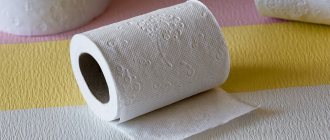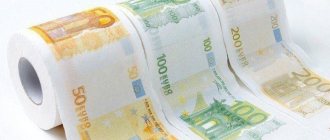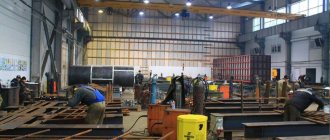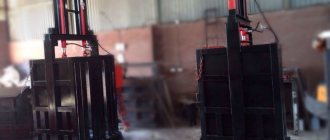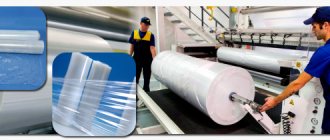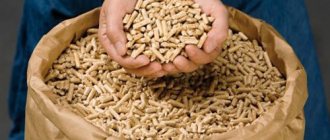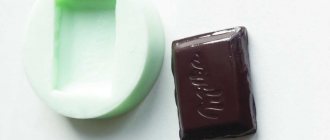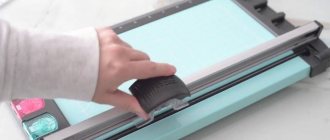Toilet paper has long become a commonplace item. It’s hard to even imagine that just a couple of centuries ago it was a luxury item, and not an ordinary household hygiene material.
The main advantage of toilet paper, from a businessman’s point of view, is that the demand for it is always stable. But competition among manufacturers is also great.
Today there are many varieties of toilet paper: single or multi-layer, white or colored, smooth or embossed, plain or patterned, unscented or scented... the imagination of manufacturers has no limits in trying to attract public demand. They even produce rolls with comics, crosswords, and collections of jokes. True, such paper costs accordingly, but its main purpose is to be an affordable and high-quality personal hygiene item.
The correct organization of any business begins with analysis and calculations. Let's consider the return on investment in a mini-factory for the production of toilet paper in stages .
Toilet paper market analysis
The profitability of any commercial project depends on the successful sale of manufactured products, and toilet paper is no exception. It is clear that there is no point in opening your own store selling toilet paper; such products are sold through chain stores and supermarkets. Such trading has both its pros and cons.
The main advantage: retail chains are large intermediaries, capable of selling large production reserves (for a “newbie” in business it is quite possible to agree on batches of up to 50-70 tons/month). That is, products will not accumulate in the warehouse, production runs smoothly.
The main disadvantage: the trade “share” of supermarkets is at least 30%, and in order for your products to be successfully placed, it’s all 50%. Naturally, this implementation is more suitable for significant volumes of large plants. For small businesses, it will be more profitable to cooperate with large wholesale stores or create their own dealer network to service stores and outlets selling household goods in the region.
There are two options for organizing a toilet paper production business:
- full production - a technological process based on recyclable materials (waste paper), the output is ready-made packaged rolls of toilet paper;
- simplified mini production - the basis is cellulose raw materials, which are rewound on special equipment, and then cut into rolls familiar to everyone and packaged.
The second option is less profitable, since the cost of such a “semi-finished product” significantly exceeds the purchase price of recyclable materials and, accordingly, reduces the possible profit. In addition, paper recycling volumes in Russia today account for about 15% of the actual amount of waste and, despite quite decent competition, this business is more promising.
Therefore, we will consider the first option for organizing production.
Starting a business
Even though “find distribution channels” is the last item on the list, you need to start there. After all, it depends on him whether your business will be successful.
We are looking for sales channels
There are two options for distribution channels - wholesalers and retail outlets.
- Wholesalers are those who will buy your product and then resell it to retail outlets.
- Retail outlets are those who sell products to the end consumer.
It is not difficult to guess that selling your goods to wholesalers is less profitable . But many novice entrepreneurs choose this option , and there are reasons for this:
- the goods will not remain in warehouses;
- it is easier to negotiate with a wholesaler than with chain super- and hypermarkets;
Call wholesalers; you can find their contacts in search results for your region. After communicating with potential wholesale partners, determine how in demand your products are.
Legal registration
You can register both an individual entrepreneur (individual entrepreneur) and an LLC (limited liability company). It is preferable to choose the second option , this will make it easier for you to organize sales of your products.
Next, buy a license . A license to produce toilet paper and napkins will cost you about 150 thousand rubles . We also add here the cost of opening an LLC - 10 thousand rubles .
If you plan to make a product from waste paper, you will not need an additional license for processing recyclable materials.
Room
When choosing a room, focus on its size . It is preferable to have an area of at least 150 square meters. m . It will have to be divided into at least three parts:
- production area;
- raw materials warehouse;
- finished goods warehouse.
If your warehouses are located far from the production workshop , you will need to buy a truck, hire a driver and loaders, and this is a considerable expense . So, when choosing a room, immediately take into account its size and the number of products you plan to produce. If you are going to recycle waste paper, take this fact into account - the equipment will require additional space.
To save money, rent warehouses and workshops on the outskirts of the city or even outside it.
Staff
three to six people to service all types of equipment .
If you plan to run uninterruptedly , multiply this number by three : thus, the staff will work eight hours in three shifts.
As a rule, no special skills or experience are required from people servicing paper machines .
Learning is fast and the machines are intuitive to use. In addition, many equipment suppliers themselves will teach your staff all the necessary skills and abilities for free.
In addition to the workshop workers, you will need services :
- driver;
- loaders;
- accountant;
- cleaner;
- watchman.
These positions can be combined with each other, or some function can be performed by the business owner (that is, you).
Where to get raw materials?
The raw material is waste paper.
for making toilet paper and napkins :
- old newspapers;
- office paper;
- notebooks;
- packaging paper and cardboard;
- corrugated cardboard.
It is clear that you will not be able to collect waste paper for production yourself. Therefore, immediately decide where to get it. There are at least two options:
- contact the owners of waste paper collection points;
- open your own item.
Buy from collectors
If you do not want to accept waste paper, negotiate with other acceptors. As a rule, they hand over the collected waste paper to resellers at not very favorable prices; less often, they work directly with pulp and paper mills.
Be that as it may, most of them will be interested in cooperation with you , because:
- working with resellers, they lose part of their income;
- Working with the pulp and paper mill, they wait months for payment for the delivered raw materials (this is the nuance of working with the plant).
Find out the conditions under which waste paper collection points operate with your partners, and offer them more profitable ones . Having established contacts with several points, consider that the raw materials for production are in your pocket.
Open a waste paper collection point
By opening your own collection point, you “rigidly” provide yourself with raw materials and cease to depend on their supplies .
You don't need a large investment to get started. If you have a storage space (a garage is a good place to start) and a car with a trailer , you can open a collection point in almost one day. The main thing is to find suppliers of raw materials.
How to open a waste paper collection point is described in detail in a separate article. By the way, if the toilet paper and napkin business doesn’t work out for some reason, you will have a backup option in the form of a collection point, which also brings in a stable income and will help you “recoup” the money invested in the equipment.
Manufacturing technology from waste paper and its advantages
Toilet paper and napkins are made from:
- wood pulp;
- recycled waste paper;
- rag half mass.
Manufacturing from waste paper has a number of advantages:
- widespread availability and low cost of raw materials;
- environmental friendliness (riding nature of garbage and reducing the need for deforestation).
Manufacturing products directly from waste paper implies a full production cycle.
An incomplete cycle means production from a finished paper base.
An incomplete production cycle implies the purchase of more expensive raw materials, so it is more profitable to establish a full cycle.
Let's consider the full production cycle . It takes place in several stages:
- Sorting and shredding paper pulp into small fragments (1-5 cm). Crushers are used for this.
- Processing of paper pulp in a pulper and dissolution into fibers.
- Cleaning the mass from impurities and foreign objects using catchers (some models of pulpers are equipped with them).
- Making paper products from the resulting water-paper solution using a paper making machine.
- Winding, cutting and packaging of products using special machines.
Read more about the waste paper recycling process in this article.
Opening a company and necessary permits
For the production of toilet paper, it is preferable to open a legal entity as a form of ownership (for example, LLC). It is more profitable for large suppliers to cooperate with a law firm than with a private entrepreneur. In addition, it is easier for a legal entity to obtain all the necessary certificates and permits.
The approximate cost of registering an LLC will be 10,000 rubles. To open production, you will need to obtain a license, which will cost 140,000 rubles.
The production of toilet paper in Russia is regulated by GOST “R 52354-2005”. To implement it, you will need to issue a sanitary-epidemiological report and a certificate of conformity, for which you will need the following documents:
- certificates for raw materials;
- lease agreement for production space;
- certificate of registration, charter of the enterprise, etc.
Where to start starting a business
Having become familiar with the stages of production, you can develop a plan for the production of toilet paper as a profit-generating business.
Enterprise registration
Business registration is required to operate legally. They apply for it to the Federal Tax Service at their place of residence.
If an entrepreneur plans to manufacture products in a small workshop and in small volumes, then it will be more convenient for him to register himself as an individual entrepreneur. Registering an individual entrepreneur is cheaper and does not take much time.
But it is worth remembering that large companies prefer to work as legal entities. Therefore, registering an LLC is better suited, as it involves a large business with outside investments and several managers. If an entrepreneur does not have enough funds to open a business, he can apply for a loan as a legal entity.
The price for registering your own enterprise will be 10,000 rubles.
In addition to the business registration document, you need to obtain the necessary licenses and permits from the sanitary-epidemiological station.
Documentation
List of required documentation:
- Raw material quality certificates.
- Agreement for the purchase or lease of premises.
- Certificate of registration of the enterprise.
A license from the sanitary-epidemiological station costs 140,000 rubles.
Selecting premises for production
For the production of small batches of toilet paper, in the early stages of business, a workshop can be equipped in a garage.
To undergo the full technological process, the workshop premises must meet certain parameters.
- The area must be 150 square meters or more. The height of the walls should not be lower than 4 meters.
- The production area must be well heated and ventilated.
- According to sanitary conditions, the workshop must be equipped with a sewerage system, three-phase power supply and water supply.
The workshop area is divided into three zones:
- Raw materials warehouse.
- Production line.
- Warehouse
Purchase of equipment
It is necessary to purchase the following equipment for the production of toilet paper:
- Paper making machine. It consists of the following parts: a device for cleaning waste paper, an electric generator, a hydraulic diluting device, a vibrating sieve, a mill with various functions, a washing apparatus, and a device for mixing the mass.
- Machine for cutting rolled blocks. The height of this device can be adjusted so that paper rolls of different sizes can be produced. Direct cutting is carried out using a strip knife.
- A reel-unwinding machine on which the strength and softness of toilet paper is established.
- A packaging machine where ready-made toilet paper rolls are packaged in plastic packaging.
First, you can buy old equipment, the cost of which is much lower. Then you should take into account the lack of warranty repair of machines, unexpected breakdowns and downtime on the production line.
For consumers accustomed to comfort, you can purchase a machine for making cardboard sleeves. It costs approximately 100,000 rubles. But if you plan to produce regular paper, then such a machine will not be required.
A distinctive feature of a product is its packaging. It is worth developing a logo for toilet paper in advance and printing it in a printing house.
Recruitment for production
At the starting stage of the business, the production workshop will be able to be serviced by four people. As the business expands, the staff needs to be increased, since overworking of employees has a bad effect on productivity.
In addition to shop workers, you will need to hire an accountant, a technologist, a storekeeper and a driver. An entrepreneur himself can deal with administrative issues if he has sufficient qualifications.
Choosing a room for toilet paper production
A workshop for the production of toilet paper must have an area of at least 150 m2 and a ceiling height of 4 m.
The premises will be divided into three main zones:
- Warehouse for storing raw materials;
- Production Line;
- Warehouse for finished products.
Basic requirements for the premises: availability of running water (water requirement - 3 m3/day), sewerage, electricity (with 3-phase power supply of 380 W). The estimated rental cost per month, based on a price of 500 rubles/m2, will be 75,000 rubles.
Technical characteristics of some production lines
Finished production lines are divided into two types according to the technological process:
- equipment for production from finished raw materials is the most affordable and simplest option;
- mini-plant for recycling waste paper - includes a set of mechanisms for preparing paper raw materials. This option is more complex, but includes all stages of the production process, and significantly reduces the cost of production.
In Russia you can find equipment not only imported, but also domestically produced, new and used.
Rewinding machine YD-E
For example, the automated complex ALBP-1 (NIKA, Russia) is designed for the production of toilet paper from waste paper. Characteristics:
Automatic line ALPB-1 LLC "NIKA"
- productivity – up to 4 tons per shift;
- power – 20 kW;
- required power supply – 380 V;
- required premises – 200 m2;
- cost – 8,000,000 rubles.
A more budget-friendly version of a complex for the production of toilet paper, but without a line for recycling waste paper, is the ZS-E-1380 model. Characteristics:
- productivity, logs per minute – 6 pcs.;
- power – 5.5 kW; Rewinding machine ZS-E-1380
- dimensions: length – 5050 mm;
- width – 2600 mm;
- height – 1800mm;
Electric mini-factory for the production of toilet paper from recycled materials from Russia, Omsk.
Omsk Paper Mill
Specifications:
- output – up to 1000 kg per shift;
- power – 160 kW/h;
- service – 4 people;
- required production area – 150 m2, ceiling height – 4 m;
- cost – 1,900,000 rubles.
Toilet paper manufacturing technology
1) Preparation of waste paper pulp
Recyclable materials are cleaned of foreign impurities and crushed in a crusher with the addition of water. The wet crushed mass is filtered through a special sieve, on which small foreign inclusions that were missed during the initial cleaning (paper clips, glass, clips, etc.) remain.
2) Washing of raw materials
The purified mixture is sent to the tank, where it is washed with tap and recycled water. Not only the quality of future paper depends on the thoroughness of washing at this stage (the longer the washing, the whiter the raw material), but also the cost price (water consumption). Dirty water is washed down the drain.
3) Fine grind
The raw materials, together with clean water, are crushed into a water-paper mass using a multifunctional mill, and then pumped into a pressure tank.
4) Concentration regulation
From the pressure tank, the mass is sent to a special container, where the proportional composition of the mixture of raw materials and water is regulated. After achieving the required parameters, the mass is poured in a uniform flow onto the mesh table of the papermaking machine.
5) Production of roll blanks
The suspension is dewatered using a nylon mesh, which also serves as a conveyor belt. Excess liquid flows into a tank for circulating water, which is reused when washing raw materials. The paper pulp is conveyed along a belt into a drying drum rotating at a speed of 10 revolutions/minute, which is heated by steam to a temperature of 110 degrees. The mass dries in the drum, after which it is removed with a scraper knife. The cut tapes are dried and wound onto a sleeve into bobbins, which are then cut into roll blanks.
6) Unwinding and embossing
The reel produced on the paper-making machine is placed on an unwinding machine for embossing and simultaneous rewinding into a log (a roll equal in width to the reel and in diameter to a regular roll of toilet paper). Such rewinding is necessary to form the structure of the web (two-layer, three-layer paper) and a denser roll.
7) Packaging and slicing
The resulting log is pasted over with a label, which should be ordered in advance from the printing house, and cut into rolls on a special cutting machine. The cut rolls are checked by weight, packed in boxes or plastic bags and ready for sale.
Production process
The technology for making toilet paper includes three stages:
- preparation of paper raw materials:
- production;
- roll cutting and packaging.
For short-cycle equipment, the first stage can be omitted; finished raw materials can be purchased from large enterprises.
Toilet Paper Production Line
For mini-plants that include a waste paper processing line, the first stage involves the preparation of raw materials:
- Shredded and cleaned recyclable paper is loaded into the container and filled with water;
- the resulting mass is placed in a pulping mechanism for further grinding and softening;
Toilet paper cutting machine - the resulting raw materials enter the preparatory tank for enrichment with water and bringing to the required state;
- Using a mill pump, the mass enters the constant flow box. In this tank, the raw materials are saturated with oxygen using a vacuum pump;
- further, the mass passes through the mesh table, which is in constant motion. The paper raw material is evenly distributed over the entire surface and sent to a special squeezing mechanism - the couch roll;
- the dewatered mass is delivered, using a felt conveyor, to the heating drum, and the liquid
Toilet paper production
is returned to the first receiving bin for reuse; - the heating drum has the same temperature over the entire surface, passing through it, the paper raw material evaporates up to 65% of the moisture;
- to separate the mass from the walls of the drum, a scraper knife is used;
- The paper webs, passing over the drying cloth, enter the receiving device and are wound there, forming bobbins.
How is toilet paper made?
Paper making machine. Paper machine The second stage is performed by the paper machine:
- The reel-unwinding installation rewinds paper webs into logs - rolls of the required diameter and width. This results in rolls with greater density;
- at this stage you can perform embossing;
- the finished log is covered with wrapping paper and goes to the receiver.
Third stage:
- from the receiving department, the log is sent to the cutting station for cutting in accordance with the specified parameters;
- The finished rolls enter the packaging machine and are packed into boxes for sale.
Equipment for making toilet paper
It is planned to purchase a technological line to complete a mini-plant with a capacity of 1 ton/day, costing RUB 2,000,000 including delivery, turnkey installation and personnel training.
The equipment set includes:
1) a paper-making machine, which includes a set of equipment for cleaning raw materials and producing paper:
- electric generator,
- pulper,
- vibrating sieve,
- multifunctional mill,
- washing machine,
- cleaners,
- stirrers.
2) a machine for cutting rolls;
3) reel-unwinding machine;
4) packaging machine;
5) pasting table.
There is no shortage of manufacturers of technological lines for processing recyclable materials and making paper. Therefore, it is worth choosing someone who can provide not only installation and startup work, but also repair work, if necessary. After all, a simple line is your loss.
Additionally, it is recommended to purchase a machine for the production of cardboard sleeves, so as not to purchase ready-made ones. The cost of such equipment is 110,000 rubles. However, the log may not have bushings if you plan to produce standard rolls without an internal cavity.
In the future, it is possible to expand production with equipment for the production of napkins, paper towels, etc.
Homemade reed paper production
You can make excellent paper with your own hands from ordinary reed. It is convenient to paint with gouache and watercolor on it, so reed paper can be a suitable material for postcards, crafts and unusual sketches.
To make paper, you need to collect the reed, wash it, and grind it thoroughly. After this, the raw materials must be placed in a pan, filled with clean water and brought to a boil. Then take 100 grams of alkali and dilute it in a glass of water, the mixture is added to the boiling cane mass.
After 30 minutes, the pan can be removed from the heat and the water drained. The cane is carefully sorted, all hard fibers must be removed and the rest crushed using a blender or food processor. A few tablespoons of brewed starch will help make the mixture more homogeneous.
The mixture is whipped again until smooth, reminiscent of porridge in consistency. The mass must be carefully scooped out with a frame. The mixture is distributed as evenly as possible throughout the frame. After this, you need to remove excess moisture from it using a sponge or old newspapers. The mass is then transferred to fabric and dried for several days.
Raw materials for the production of toilet paper
Recycled paper of the following brands is suitable as a raw material for making paper:
- MS-1 (bleached cellulose paper without ruling and printing);
- MS-2 (white paper with a line);
- MS-3 (book and magazine paper);
- MS-7 (cardboard);
- MS-10 (newspapers).
It is necessary to additionally purchase mesh and felt (for paper), paper glue and cardboard (for gluing the bushings) or ready-made purchased bushings. To avoid problems with obtaining a permit, it is better to purchase all raw materials from trusted suppliers with appropriate quality certificates.
Promotion and sales of products
As a business, the toilet paper industry requires promoting its own brand. The image of any brand consists of a memorable name, logo and bright, eye-catching packaging. In addition to developing the visual component, you need to work on the product range. The initial data necessary for this can be obtained by studying the local market and identifying the types of products most in demand among the target audience.
No less important for the mini-production of toilet paper is the organization of sales: in fact, the workshop must sell one and a half to two tons of products per day. Therefore, when developing a strategy, you should focus on wholesale buyers: you can interest them with the help of dumping prices and discounts when ordering large volumes of goods. To find such partners use:
- Cold calls. You need to call every day the heads of all distribution companies, wholesale warehouses and warehouses in the region, offering them profitable cooperation;
- Newsletters. Commercial offers should be sent to both prepared and unprepared clients using regular and e-mail;
- Publication of advertisements. It is necessary to place information about your products in special catalogs for wholesalers;
- Negotiation. It is recommended to negotiate with the owners of retail chains and supermarkets about including their products in the assortment of their outlets.
Registration and premises
Before starting paper production, you will need to register yourself as a legal entity.
The best registration option is a limited liability company, because it is much more convenient and profitable for large supplier companies to work with a legal entity.
You must also obtain required permits, licenses and certifications.
To sell finished products, you will need a quality certificate for your product, as well as a conclusion from the sanitary and epidemiological service.
For registration you need documents:
- For all the raw materials you use.
- Lease agreement for work premises.
- Certificate of registration of your enterprise, its status and others;
Before starting production, you also need to find a premises that meets certain requirements:
- room area – more than 150 m²;
- height - at least 4 m;
The room will have 3 main work areas:
- Material warehouse where you can store all the necessary materials.
- A separate room for all equipment , where the production process will directly take place.
- Warehouse for finished products , where manufactured products will be stored before they are sold.
Business plan
- Starting investments: from 2 million rubles;
- Profitability / payback period: 11% / from two years.
The business plan must include not only the cost of equipment (from 1 million rubles), but also:
- expenses for registering an enterprise – 150,000 rubles;
- rent approximately 50,000 - 75,000 rubles;
- costs for purchasing the base - 600,000 rubles;
- costs for purchasing labels – 30,000 rubles;
- utility and transportation costs – 80,000 rubles;
- salaries – 70,000 rubles (5 employees);
- other expenses - about 30,000 rubles.
The profitability of toilet paper production is approximately 11%. This means that the initial investment will not pay off before 2 years.
The information provided in this article is only a brief introduction to the essence of the business. If you decide to move on to implementation, then you need to download a professional business plan for the production of toilet paper with detailed calculations:
Video on the topic:
Full cycle of toilet paper production at the factory
Innovation. Vending business
A Japanese company has invented a machine that turns office paper waste into toilet paper.
The machine, called White Goat's, can make a roll of toilet paper from 40 A4 sheets in 30 minutes. All you need to do is place the paper in the machine, add water and pick up the finished roll.
While buying a roll of toilet paper costs 59 cents, the cost of making paper this way is only 17 cents.
The cost of such a machine is $100,000.
Video on the topic:
Rational use of office paper waste
Business idea: toilet paper with jokes and anecdotes
Glowing toilet paper
Necessary equipment
To establish uninterrupted production, you must purchase high-quality equipment. It can be automatic, semi-automatic or manual, so there is plenty to choose from.
Now we will describe in detail what it consists of and what equipment you will need to make toilet paper from start to finish:
Rewinding mill
Using this machine, the base is rewound into technological rolls. At the same time, the last layer is glued. On the machine, winding is carried out using cardboard sleeves or without them, depending on the type of machine.
Bushing machine
It is used to make cardboard sleeves for rolls. You can produce bushings with anywhere from two to five layers. Also, depending on the modification, you can adjust both the length and diameter of the cardboard sleeves. At first, you can, of course, do without this mill, making paper without these bushings, or purchasing them from other suppliers. But to be more economical in the future, it is advisable to purchase it.
Cutting machine
Designed for cutting rolls into blanks. Depending on its modification, they can be automatic or manually controlled.
Pasting table
Designed for manually pasting rolls with bright labels and for drying them.
Packaging machine
With its help, rolls are packaged in polyethylene film and ultimately the finished product comes out. This machine is automated. It can pack rolls in one or two tiers. If you intend to pack the rolls manually, you can purchase a packing table.
Guarantor of demand
The production of toilet paper for a businessman is quite attractive, from the point of view of a businessman opening his own enterprise.
Such products are always in demand, despite the fact that competition in the market is high.
Potential of toilet paper consumers in Russia
In addition, there is always a buyer for each type of product thanks to a wide range of paper:
- Single layer;
- Double layer;
- Colored;
- White;
- Embossed;
- Smooth;
- Plain;
- Flavored;
- Colored.
Of course, the higher the expected quality of the product, the more serious equipment for the production of toilet paper will be required. In addition, the technology for the production of kitchen paper towels is not very different from the production of sanitary paper, and therefore opens up the possibility of increasing the assortment.
